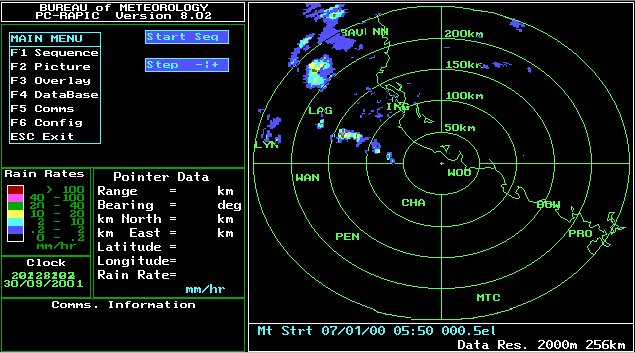The PC Rapic was the next step in an autonomous weather radar display system after the Rapic Receiver. Based on the emerging technology of the IBM Personal Computer, it was the first colour display system that did not come from a solely radar equipment source. In this case, a general computing and display product was programmed to serve a radar function.

GENERAL DESCRIPTION
The PC Rapic
Like the Rapic Receiver, the PC Rapic displayed real time weather radar data
from various radar sites as colour images with a facility to view them as an
animated sequence.
It is a Personal Computer based radar work-station designed to receive, store
and display radar data. It offers sequencing, database, communications, hard
copy, lightning display and adjacent radar image merging facilities. The sequencing
facility offers control of conversion range, sequence speed, sequence depth,
sequence zoom and many options for the loading of images from the database.
The database facility can store thousands of images on the Unit's hard disk,
and offers the ability to copy these images to and from floppy disks. Review
of significant events can be conveniently accessed from this database.
In addition to simple leased line and dial-up operation, the communications
facility manages the obtaining of images from remote radars on either a random
or periodic basis. A scheduler is provided to allow automatic collection of
radar data from multiple radar sites.
The adjacent radar merge function allows adjacent radars to contribute to an
image presented on the screen in a sequence. Where sufficient overlap of radars
exist, a complete coverage of areas up to 1024km x 1024km is available on one
screen. The system automatically searches the database to locate as many images
as can contribute to the image
Color hard copy output is supported for a number of printers. The system also
includes facilities to integrate radar and lightning data at sites where lightning
data is available.
OPERATION
The user interface of the PC Rapic system is menu driven, with options selectable
by a point and click mouse operation, function keys may also be used to make
selections.
Beyond the zoom, change range, offset image, display overlay maps and symbols
there are a number of enhanced facilities. Some of these are:
DATABASE SIZE CONTROL
A facility is provided to limit the maximum data-base size to a given number
of Megabytes.
MAP EDITING:
A Map Edit option is provided in the OVERLAY menu. This option allows text to
be added, deleted, edited and moved. Lines may also to be added to maps.
TRACK MARKING FACILITIES
A mechanism is provided for marking the track of meteorological events, e.g.
cyclones and thunderstorms.
RADAR CONTROL FACILITIES (SESSIONS):
A capability is included to conduct interactive sessions with radars. Using
this facility it is possible to demand PPI's and Range Height displays in real
time from the radar. Availability of this facility is controlled and limited
by the COMMINFO.CMI file. This is usually limited to selected users only.
NETWORK OPERATION:
The PC Rapic can operate on a database over a network. In this case, the database
files are owned by the master PC-Rapic, ie the one communicating with the remote
radars.
Other PC Rapic displays then run in the SLAVE mode, with read-only access to
the database. In this mode of operation, the SLAVE PC Rapic displays will refresh
their current sequence once every minute, to ensure that the sequence is kept
up to date.
References
1. PC Rapic
Display System Operators Manual